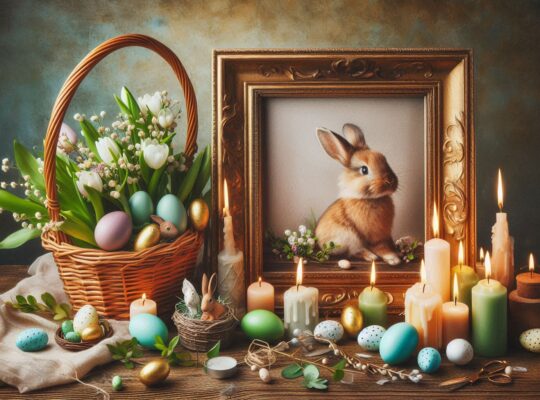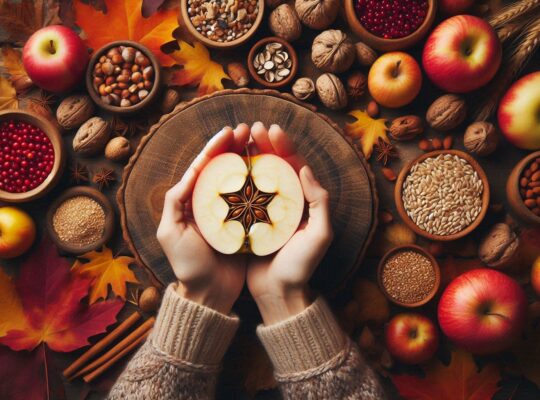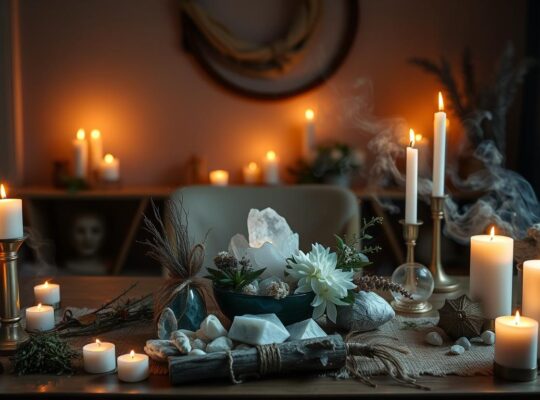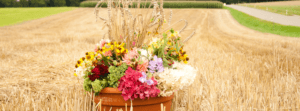Samhain: Honoring Ancestors & Celebrating the Wheel’s Turning
As autumn leaves fall and darkness grows longer, the Wheel of the Year turns to welcome Samhain, the ancient Celtic new year and third harvest festival. This powerful time marks the threshold between summer’s end and winter’s beginning, when the veil between worlds grows thin and we’re invited to honor our ancestors, reflect on the cycle of life and death, and embrace the wisdom of the shadow season. In this guide, we’ll explore simple ways to connect with Samhain’s transformative energy through healing rituals that honor both endings and beginnings.
When Samhain’s Veil Thins
Samhain (pronounced “SOW-in” or “SAH-win”) is traditionally celebrated on October 31st through November 1st in the Northern Hemisphere. In 2025, many will observe this sacred time on Friday, October 31st. This significant holiday marks the midpoint between the Fall Equinox (Mabon) and the Winter Solstice (Yule), when the final harvest is gathered and nature begins its journey into winter’s rest.
After Mabon’s balanced light and darkness in September, Samhain brings us fully into the dark half of the year. This doesn’t mean darkness in a negative sense, but rather in the nurturing, restorative way that seeds need darkness to germinate and we need sleep to heal. The name “Samhain” comes from ancient Celtic words meaning “summer’s end,” reflecting the completion of the growing season and the beginning of the quiet, introspective time.
For our ancestors, Samhain marked the Celtic new year—a time when the barriers between the physical and spiritual worlds became permeable, allowing communication with ancestors and loved ones who had passed beyond the veil. This makes Samhain ideal for honoring family history, remembering those who’ve shaped our lives, and acknowledging death as a natural part of life’s cycle.
Ancient Wisdom of Samhain
For thousands of years, cultures worldwide have marked this transitional time with festivals honoring ancestors and acknowledging the thinning veil between worlds. Our ancestors understood that this moment marked an important transition—when the active, outward energy of summer and harvest gave way to the reflective, inward journey of winter.
In Celtic traditions, Samhain was considered the most significant of the four fire festivals. Communities would extinguish all household fires, then relight them from a common sacred flame, symbolizing unity and purification. Feasts featured foods from the final harvest, while rituals honored the ancestors and protected against harmful energies during this liminal time.
Many modern Halloween traditions trace their roots to ancient Samhain customs. Jack-o’-lanterns evolved from turnips carved with frightening faces to ward off unwelcome spirits. Costumes originated from the practice of disguising oneself to avoid recognition by mischievous entities when the veil was thin. Even trick-or-treating echoes the old custom of leaving food offerings for ancestral spirits or the fae folk.
When we celebrate Samhain today, we join this ancestral lineage of honoring life’s transitions. Their simple wisdom reminds us that death and life are interwoven parts of the same sacred cycle—and that acknowledging endings with respect creates space for meaningful new beginnings.
Samhain’s Special Symbols
Samhain gives us meaningful symbols that connect us to this powerful transition time. The cauldron represents transformation, rebirth, and the womb of the Goddess—a container where endings become beginnings. Working with a cauldron (even a small one) helps us understand how apparent endings often hold the seeds of new growth.
Apples remain sacred at Samhain, representing wisdom, immortality, and the hidden star within (cut an apple horizontally to see a pentacle in the core). Apples were traditional for divination games like bobbing for apples, which originally helped young people discover insights about their future partners or paths.
Pumpkins and jack-o’-lanterns serve as protective guardians at the threshold between worlds. Their carved faces and inner light represent our own inner wisdom illuminating the darkness. Creating a jack-o’-lantern with intention connects you to this ancient protective practice.
The ancestral altar honors those who came before us—both blood relatives and spiritual ancestors who’ve shaped our path. Creating a space with photos, mementos, and offerings acknowledges that our ancestors remain part of our story and accessible during Samhain’s thin-veiled time.
The color black represents the nurturing darkness of the womb and soil where transformation happens, while orange symbolizes the hearth fires that sustain us through winter. Purple acknowledges spiritual wisdom, and white honors the ancestors and spiritual guides who walk between worlds.
Simple Samhain Rituals for Healing
Creating an ancestor altar offers a beautiful way to connect with those who’ve crossed the veil. Set up a special space with photos or mementos of departed loved ones, spiritual teachers, or even beloved pets. Add a candle, fresh water, and perhaps small offerings of their favorite foods or objects. Spend time at this altar during the Samhain season, sharing memories, asking for guidance, or simply sitting in quiet communion with those who shaped your journey.
A candle ritual for remembrance brings comfort and connection. Gather in a darkened room with friends or family, or create this ritual alone. Each person lights a candle while speaking the name of someone who has passed and sharing a memory or quality they embodied. As the room fills with light, feel the presence of all those remembered, acknowledging how they continue to illuminate your path even after physical death.
The releasing ceremony helps you let go of what no longer serves you as the year turns toward darkness. Write on fallen leaves what you wish to release—perhaps habits, grudges, or limiting beliefs. At sunset on Samhain, burn these leaves safely in a cauldron or fire-safe container while saying: “As this leaf returns to ash, I release this burden from my path.” Visualize these challenges transforming into wisdom as they burn.
A divination practice honors Samhain’s tradition as a time when the future becomes more visible. Simple methods include scrying (gazing into a bowl of dark water or a black mirror), pulling tarot or oracle cards with specific questions about your path ahead, or the ancient practice of tea leaf reading. The thinned veil during Samhain creates ideal conditions for receiving insights about your journey.
Healing Plants of Samhain
As autumn deepens toward winter, certain plants offer special healing benefits:
- Rosemary stands as a powerful herb of remembrance, helping us honor and connect with ancestors. Its needle-like leaves stay green even in winter’s cold, symbolizing the continuity of life. Place sprigs on your ancestor altar, use it in protective incense, or simply brush your hands across a rosemary plant to release its memory-enhancing scent.
- Mugwort enhances psychic awareness and dream work, supporting the natural increase in intuitive abilities during Samhain. This silvery plant has long associations with the moon and between-worlds work. A small sachet of dried mugwort under your pillow may bring more vivid dreams during this time when the veil thins.
- Elder trees have traditionally been considered guardians of the threshold between worlds. Their berries (properly prepared) support immune health as we enter winter, while their hollow branches were traditionally used to make flutes or whistles that could call between worlds. Simply spending time with an elder tree during Samhain creates connection to ancestral wisdom.
- Apples reach their final harvest now, offering both physical nourishment and spiritual symbolism. The five-pointed star hidden within each apple represents protection and the elements in balance. Sharing apples at Samhain connects you to ancient divination customs while providing antioxidants and fiber for physical wellness.
- Oak leaves and acorns carry the strength and wisdom of the mighty oak as it prepares for winter rest. Gathering fallen oak leaves for your altar honors this sacred tree that was revered by druids and many ancient cultures. Oak brings stability during times of transition, helping us stay grounded as the veil thins.
Creating Your Samhain Altar
Your Samhain altar becomes a focal point for honoring ancestors and marking the year’s turning—a sacred space where memory meets magic and endings transform into beginnings. Create this space with reverent presence, letting your heart guide what feels right.
Photos or mementos of ancestors create the foundation of a traditional Samhain altar. Include both blood relatives and spiritual ancestors who’ve influenced your path. Personal items that belonged to them create especially strong connections during this thin-veiled time.
Candles in black, orange, purple, or white illuminate your sacred space. As you light each one, speak the names of those you wish to honor or qualities you seek to cultivate during the dark season ahead. Black candles represent the protective darkness and transformation; orange symbolizes the hearth fire’s warmth; purple acknowledges spiritual wisdom; white honors ancestors and clarity.
Seasonal items from nature—gourds, pumpkins, autumn leaves, pine cones, and acorns—ground your altar in the current season’s energy. These natural elements remind us that death is part of nature’s cycle, not something to fear but to honor as part of the great turning wheel.
A small cauldron or bowl can hold water as an offering to ancestors or serve as a vessel for releasing rituals. Water represents the emotional realm and the fluid nature of the veil between worlds at Samhain.
Crystals that support Samhain’s energy include smoky quartz for grounding and ancestral connection, obsidian for protection and shadow work, and clear quartz to amplify intentions and communication across the veil. Place these stones in moonlight before adding them to your altar.
Let your altar evolve throughout the Samhain season, perhaps adding fresh offerings or candles, or changing elements as you feel guided. This sacred space honors both those who have crossed the veil and your own journey through the cycle of seasons.
Foods for Samhain Celebration
Samhain traditionally honors the final harvest before winter and the gifts of those who came before us. Creating a feast that features seasonal foods connects you to both the earth’s cycles and ancestral traditions.
Soul cakes, a traditional Samhain and All Souls’ Day food, were originally given to those who went door-to-door saying prayers for the dead (an early form of trick-or-treating). These simple spiced cookies or cakes remind us of the ancient practice of feeding both the living and the spirits during this thin-veiled time. Sharing soul cakes with friends while telling stories of ancestors creates meaningful connection.
Apples feature prominently in Samhain traditions across cultures. Enjoy them in pies, cider, or the traditional Irish dish of colcannon (mashed potatoes mixed with kale or cabbage) with a hidden apple slice that brings good fortune to whoever finds it. The apple’s five-pointed star revealed when cut horizontally reminds us of the hidden magic within ordinary things.
Root vegetables like turnips, potatoes, carrots, and beets represent the earth’s final offerings before winter and foods that sustained our ancestors through cold months. Roasting these vegetables with herbs creates a grounding, nourishing dish that honors both the harvest and those who taught us to preserve food for leaner times.
Nuts and seeds were traditionally used for both divination and sustenance at Samhain. Adding pumpkin seeds, walnuts, or hazelnuts to dishes connects you to ancestral practices while providing protein and healthy fats. The tradition of “nutting” (gathering wild nuts) at Samhain reinforces the practice of preparing for winter.
Dark breads made with whole grains and seeds offer a simple way to connect with ancestors who relied on bread as a staple food. Breaking bread with loved ones while leaving a piece as an offering for those who have crossed the veil honors the continued connection between living and dead at Samhain.
Approach cooking as a sacred act—an opportunity to connect with ancestral wisdom through food traditions. Consider making a family recipe passed down through generations, or researching traditional foods from your cultural heritage. As you prepare these foods, invite the loving presence of those who cooked these dishes before you.
Divine Guides of Samhain
The spiritual beings connected to Samhain can support your seasonal journey. Think of them as helpful energies rather than distant figures—aspects of wisdom that you can connect with through intention and awareness.
The Crone or Wise Woman aspect of the Goddess represents the wisdom that comes with age and experience. Often depicted as Hecate, Cerridwen, or Cailleach, she guides us through transitions and teaches the value of both endings and beginnings. The Crone knows that death is not truly an end but a transformation, and she helps us navigate the thinning veil with courage and wisdom.
The Ancestors themselves become powerful guides during Samhain. These include not only blood relatives but also spiritual ancestors—those whose wisdom, writings, art, or example has shaped your path. During this thin-veiled time, they become more accessible for guidance, healing of family wounds, and sharing their knowledge across generations.
The Lord of Misrule represents the transformative power of temporarily stepping outside normal social boundaries. This figure, known in various traditions as the Holly King or the Dark Lord, teaches the value of seeing life from a different perspective. Like the tradition of wearing costumes at Halloween, connecting with this energy helps us understand ourselves and others in new ways.
Psychopomps—guides of souls between worlds—hold special significance at Samhain. Figures like Anubis (Egyptian), Hermes (Greek), or Morrigan (Celtic) assist with transitions between life and death. Their energy supports healthy grieving, communication across the veil, and understanding death as a sacred passage rather than an endpoint.
These divine energies exist both in world mythologies and within our own consciousness. They don’t require elaborate rituals—just an open heart and willingness to recognize their qualities in nature and within yourself.
Community Healing at Samhain
Samhain traditionally brings people together to remember ancestors, share the final harvest, and prepare for winter’s introspection. This social aspect reminds us that transitions and grief are easier when faced in community rather than isolation.
Consider hosting a dumb supper—a ritual meal eaten in silence with places set for ancestors. Each participant brings a dish that honors their heritage or a departed loved one. Before eating, stories are shared about those being remembered. Then, silence is observed as the meal is eaten, creating space for ancestral presence to be felt. This powerful tradition brings healing to grief while strengthening bonds among the living.
Memory sharing circles create space for collective remembrance. Gather friends or family to share stories, photos, or objects connected to those who have passed. This simple practice prevents lost family history, honors diverse perspectives on shared ancestors, and allows younger generations to connect with those they may never have met physically.
Community ancestor altars in public spaces welcome participation from diverse backgrounds. Setting up such an altar in a library, community center, or place of worship with an invitation for people to add photos or mementos creates inclusive honoring of collective ancestors. This practice reminds us that while cultural expressions may differ, honoring those who came before us unites rather than divides.
Samhain service projects honor ancestors through action. Organizing cemetery cleanups, recording oral histories from elders, or supporting causes that were important to departed loved ones transforms grief into meaningful contribution. These acts of service create living memorials that extend ancestral legacies into the future.
Through these connections, we embody Samhain’s medicine of honoring endings and beginnings. We remember that healing flourishes in community—with the living, with our ancestors, and with the cycles that connect all existence.
Journal Writing for Samhain Reflection
Writing in a journal helps us process transitions and connect with ancestral wisdom. Find a quiet moment near your ancestor altar or outdoors under moonlight, light a candle representing Samhain’s transformative fire, and explore these questions:
Who are the ancestors—both of blood and of spirit—who have shaped your path? Consider relatives, teachers, historical figures, or even fictional characters whose wisdom guides you. How do their gifts continue to live through you?
What has completed its cycle in your life since Mabon (the Fall Equinox)? Just as trees release leaves that have fulfilled their purpose, what might you honorably release—perhaps completed projects, outgrown relationships, or limiting beliefs that no longer serve your growth?
What wisdom have you harvested from challenges faced this year? Samhain invites us to find the learning within difficulty. What strengths or insights have emerged from your struggles that will sustain you through winter’s introspection?
How might you honor grief as a natural expression of love? Our culture often rushes grief or treats it as something to overcome, but Samhain teaches that grief is sacred testimony to our capacity for connection. What losses might need gentle acknowledgment?
What aspects of yourself have remained in shadow that might offer wisdom when approached with compassion? Just as Samhain honors the dark half of the year as necessary and sacred, what parts of yourself might deserve similar recognition rather than judgment?
What dreams or intentions will you carry into the dark season for gestation? Like seeds that require darkness before sprouting, what possibilities might benefit from quiet development during winter before emerging in spring?
Before writing, you might hold an object connected to an ancestor—perhaps a piece of jewelry, a tool they used, or simply a stone from a place that was significant to them. Feel their energy supporting your reflection, remembering that their wisdom remains accessible, especially during Samhain’s thin-veiled time.
Tarot Cards for Samhain Insight
Tarot cards offer powerful insights during Samhain when the veil thins and intuition naturally strengthens. These card spreads act as bridges between conscious and unconscious wisdom, helping you access deeper understanding of your path at this turning point in the wheel.
The Ancestral Wisdom Spread helps connect with guidance from those who have crossed the veil. Find a quiet space near your ancestor altar if possible, or somewhere you feel protected and at peace. Take three deep breaths, grounding yourself while also opening to subtle communication.
Draw your first card asking: “What message do my ancestors have for me at this time?” This card reveals guidance or wisdom being offered across the veil—perhaps encouragement, a warning, or confirmation of your path.
Your second card answers: “How can I honor my ancestors through my actions?” This card suggests practical ways to carry forward their legacy or heal family patterns through your choices.
The third card reveals: “What ancestral gift or strength lives within me?” This card shows qualities or abilities you’ve inherited—whether through genetics, upbringing, or spiritual connection—that support your journey.
Your final card provides insight by answering: “What is completing its cycle in my life, and what new beginning does this create?” This card illuminates the natural pattern of endings becoming beginnings that Samhain embodies.
After completing your reading, sit quietly with the insights revealed. Rather than rushing to action, let the wisdom settle like leaves gently falling to earth. Perhaps place a significant card on your Samhain altar as a focus for further meditation during this thin-veiled season.
Between the Worlds: A Simple Samhain Ritual
As Samhain approaches, prepare for a ritual that honors ancestors and acknowledges the turning wheel from light to dark. This ceremony creates space for remembrance, release, and receiving guidance from beyond the veil.
Gather these items: candles in black and white (representing the balance of endings and beginnings); photos or objects connected to ancestors; a small cauldron or fire-safe bowl; paper and pen; seasonal items like apples, nuts, or autumn leaves; and a special cup or glass for offering water or another beverage.
Create sacred space through cleansing—perhaps by burning protective herbs like rosemary or mugwort, ringing a bell nine times (traditionally believed to clear negative energies), or simply visualizing protective light surrounding your space. Arrange your materials somewhere you feel comfortable and undisturbed.
Begin your ceremony by sitting or standing quietly, holding something connected to your ancestors. This could be a family heirloom, a photo, or simply an object that reminds you of someone who has passed. Feel the connection between worlds strengthening through this physical link.
Light the black candle first, saying: “I honor endings, transitions, and the wisdom of darkness. I acknowledge all that has completed its cycle.” Take a moment to reflect on what you’re ready to release as the wheel turns.
Light the white candle from the black one, saying: “I honor beginnings that emerge from endings, the continuous cycle of transformation. I welcome new growth that will come after winter’s rest.” This connected lighting symbolizes the unbroken cycle of existence.
Now invite ancestral presence by naming those you wish to honor, saying: “I invite the loving and wise ancestors of blood and spirit who wish me well to join this sacred circle. I welcome your guidance and protection during this thin-veiled time.” Leave moments of silence between names, feeling each presence arrive.
Write on small papers things you’re ready to release—completed projects, outworn beliefs, habits that no longer serve you. One by one, carefully burn these in your cauldron (or fold and submerge in water if fire isn’t possible), saying: “I release what has fulfilled its purpose, transforming endings into wisdom.” Feel a lightening as each is transformed.
Pour water or another beverage into your special cup, raising it in a toast to your ancestors, saying: “To those who have walked this path before me, I offer gratitude for your legacy, your lessons, and your continued presence in my life.” Take a sip, then pour some as an offering into a bowl or directly onto the earth outside after your ritual.
Sit in silence for a while, opening to any messages or feelings that come. Sometimes ancestral communication comes as words, but often it arrives as sensations, memories, or sudden knowings. Trust what you receive without judgment.
Close your ritual by thanking your ancestors for their presence, extinguishing the candles (many traditions believe blowing out candles sends your wishes to the spirit world), and grounding yourself by eating something nourishing—ideally foods connected to your heritage.
In the days following Samhain, notice dreams, synchronicities, or unusual encounters that might carry messages from beyond the veil. The communication opened during your ritual often continues throughout the Samhain season.
Embracing Samhain’s Transformative Wisdom
As the wheel turns to Samhain, we’re invited to pause at this powerful threshold—to honor those who came before us, to acknowledge life’s natural transitions, and to find comfort in the understanding that endings always seed new beginnings. This sacred time reminds us that the veil between worlds thins not to frighten us, but to reassure us of our enduring connections beyond physical separation.
The falling leaves and first frosts show us the beauty inherent in nature’s cycles of release. We too can find grace in letting go, trusting that what has fulfilled its purpose makes room for future growth, just as compost nourishes next spring’s garden.
Samhain whispers to us about the healing that comes from honoring rather than fearing the shadow season. In a world that often avoids discussing death or grief, this ancient celebration reminds us that acknowledging transitions with reverence creates wholeness. The wisdom of our ancestors teaches that facing the reality of mortality actually deepens our appreciation for life’s precious moments.
The thinning veil reminds us that love and wisdom transcend physical boundaries—that those who have shaped our lives continue to walk beside us, especially when we open to their presence with respect and intention.
As you celebrate this special turning point, may you feel the supportive presence of your ancestors. May you find peace in releasing what has completed its cycle. May you trust the fertile darkness as it nurtures seeds of new possibilities. May you remember that you stand in an unbroken line of resilient souls who have navigated the wheel’s turning through countless generations.
The promise of Samhain is that nothing truly ends but only transforms—that love continues beyond the veil, that wisdom accumulates across generations, and that the darkest night holds within it the promise of returning light.
Blessed Samhain. May your celebrations bring comfort, connection, and the quiet magic that flows when worlds draw near.

For more seasonal celebrations, check out our guides to Mabon and Yule – the holidays that come before and after Samhain in the Wheel of the Year.







